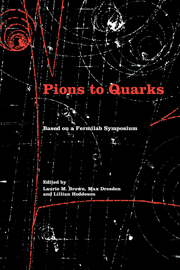Book contents
- Frontmatter
- Contents
- List of contributors
- Foreword by Leon M. Lederman
- Editors' acknowledgments
- Photographs of the symposium
- List of abbreviations
- List of notation
- I Introduction
- II Particle discoveries in cosmic rays
- III High-energy nuclear physics
- IV The new laboratory
- 9 The making of an accelerator physicist
- 10 Accelerator design and construction in the 1950s
- 11 Early history of the Cosmotron and AGS at Brookhaven
- 12 Panel on accelerators and detectors in the 1950s
- 13 Accelerators and the Midwestern Universities Research Association in the 1950s
- 14 Bubbles, sparks, and the postwar laboratory
- 15 Development of the discharge (spark) chamber in Japan in the 1950s
- 16 Early work at the Bevatron: a personal account
- 17 The discovery of the antiproton
- 18 On the antiproton discovery
- V The strange particles
- VI Weak interactions
- VII Weak interactions and parity nonconservation
- VIII The particle physics community
- IX Theories of hadrons
- X Personal overviews
- Name index
- Subject index
17 - The discovery of the antiproton
Published online by Cambridge University Press: 07 May 2010
- Frontmatter
- Contents
- List of contributors
- Foreword by Leon M. Lederman
- Editors' acknowledgments
- Photographs of the symposium
- List of abbreviations
- List of notation
- I Introduction
- II Particle discoveries in cosmic rays
- III High-energy nuclear physics
- IV The new laboratory
- 9 The making of an accelerator physicist
- 10 Accelerator design and construction in the 1950s
- 11 Early history of the Cosmotron and AGS at Brookhaven
- 12 Panel on accelerators and detectors in the 1950s
- 13 Accelerators and the Midwestern Universities Research Association in the 1950s
- 14 Bubbles, sparks, and the postwar laboratory
- 15 Development of the discharge (spark) chamber in Japan in the 1950s
- 16 Early work at the Bevatron: a personal account
- 17 The discovery of the antiproton
- 18 On the antiproton discovery
- V The strange particles
- VI Weak interactions
- VII Weak interactions and parity nonconservation
- VIII The particle physics community
- IX Theories of hadrons
- X Personal overviews
- Name index
- Subject index
Summary
I believe the antiproton story starts with P. A. M. Dirac, who in 1930 published his paper “A Theory of Electrons and Protons.” Later, the positive particles in the theory were identified as antielectrons (we call them positrons). Dirac's theory started out with electron energies that were both positive and negative. He considered the possibility that the negative-energy states were completely full, or were full except for an occasional missing electron, understanding very well that the missing electron would appear to be a positive charge. Thus, the theory called for positive particles of electron mass, namely, the positron.
The positron was promptly (in three years) found by Carl D. Anderson. His finding greatly strengthened belief in the importance of the Dirac equation. The question then on people's minds was, Does the proton have an antiparticle? I think most physicists believed that the proton did have an antiparticle, but there was some doubt. I remember someone saying: The proton has a large anomalous magnetic moment. That may be the signal that the proton is very different from the electron.
A number of cosmic-ray papers did mention the antiproton as a possible explanation of certain hard-to-explain events. For example, Evans Hay ward published a paper in 1947 that included three singular events observed in her cloud chamber. One of them (Figure 17.1) was discussed in her paper as a possible antiproton. It showed considerable shower activity attributable to a particle that might have been of proton mass entering her cloud chamber.
- Type
- Chapter
- Information
- Pions to QuarksParticle Physics in the 1950s, pp. 273 - 284Publisher: Cambridge University PressPrint publication year: 1989
- 1
- Cited by



